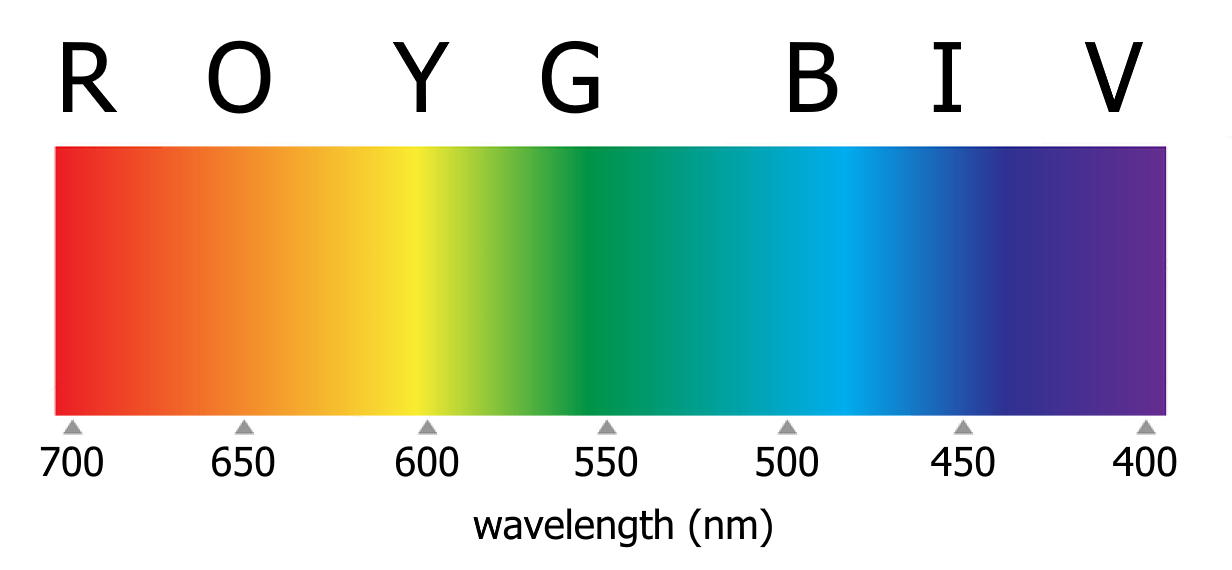
1. What is the nature and function of colour vision?
2. How can the experience of colour be described and quantified? How do colour terms develop in language?
3. What is the difference between additive and subtractive forms of colour mixing?
4. What are complementary and primary colours?
5. What is some evidence for trichromatic theory and opponent-process theory?
6. What are some types of colour deficiency?
7. What is colour constancy? What environmental properties influence this effect?
8. What is lightness constancy? How does it relate to illumination and albedo?
9. What are some psychological effects of colour?
What is the nature of colour? Is a red apple “___”?
Does “______” exist in the physical world?
Why is sensitivity to colour important?
- perceptual ___________: aids in discriminating objects from background
- kinds of animal camouflage:
• crypsis: camouflage, concealment, or disruption with respect to the surrounding environment
▸ __________ colouration: animal has same colour as its environment
e.g., snowy owl
▸ __________ colouration: pattern breaks up outline so one individual doesn’t stand out; may also produce “motion dazzle”
e.g., zebras
• mimesis: camouflage or concealment by imitation of another object
▸ ________: animal looks like another, unimportant object to predator or prey
e.g., walking stick insect
▸ _______: animal looks like other distasteful or dangerous animal
e.g., scarlet king snake
Sir Isaac Newton (1704):
- split sunlight into component colours using a prism
- ___________ correspond to (most) colours

- ________ colours: those found in the rainbow
What about ______?
- combination of red + blue light
Newton’s colour ______:
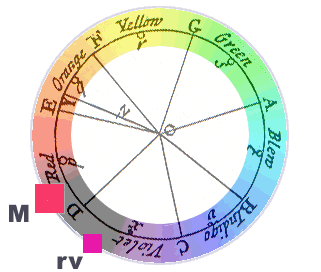
“Colour” comprises 3 physical/psychological dimensions:
• wavelength/___
![]()
• purity/__________
![]()
• intensity/__________
![]()
- only spectral colours can be hues
e.g., “______” is mixture of red and blue hues
Colour spindle/colour solid:
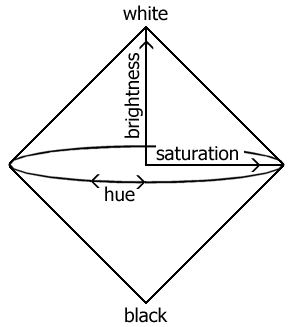
- describes all colours we can see
- slice = colour circle
- problem: some hues saturate before others
How many colours can we discriminate?
Judd & Kelly (1939): about 10,000,000
Gouras (1991): estimated perceptible levels of hue, saturation, and brightness
hues |
saturation |
brightness |
200 |
20 |
500 |
- total = 2,000,000 colours
Colour names:
- there are only ~_____ colour names in English
- Dani languages (New Guinea) only have two colour terms: mili (cool/dark) and mola (warm/light)
- Swahili: nyakundu (brown/yellow/red)
- Welsh: glas (blue/grey/green)
- Japanese: ao (green/blue)
Kay, Berlin, & colleagues (1969, 1985, 1997, 2009, 2015): World Color Survey
- anthropological study of colour ___________ in 110 languages
- if a language includes only 2 colour terms, they represent _____ and ____
- if there are 3 colour terms, vocabulary is equivalent to light (white), warm (red, yellow, brown), and dark (including black, green & blue, or ____)
- warm is always split into red and yellow before ____ is split into green and blue
- _____ hues (black, white, red, yellow, green, and blue) named before other colour terms
- if there are 7 or more colour concepts, the words for brown, orange, pink, purple, and grey are added before green or blue are subdivided (e.g., into chartreuse or azure, respectively)
- concluded there are 11 basic colour terms
- these terms emerge in _________ sequence in any language:
black, white |
red |
green or yellow |
blue |
brown |
orange, pink purple, grey |
- may be due to commonalities in the physiology of the visual system
- light having a single wavelength at 570 nm = yellow
- green (500 nm) + red (650 nm) lights = ______
- ________: two lights with different wavelength distributions, but appearing identical in colour
- metamers must produce identical neural activation
• ________ colour mixture: mix light of different wavelengths
- mix red and green = ______
- mix all colours = white
e.g., computer or TV screen pixels
• ___________ colour mixture: mix paint (or ink) of different pigments
- mix red and green = ____-_____
- mix all colours = black
e.g., inkjet printers mix pigments (usually yellow, magenta, & cyan)
- paint absorbs (subtracts) wavelengths except the one you perceive it having
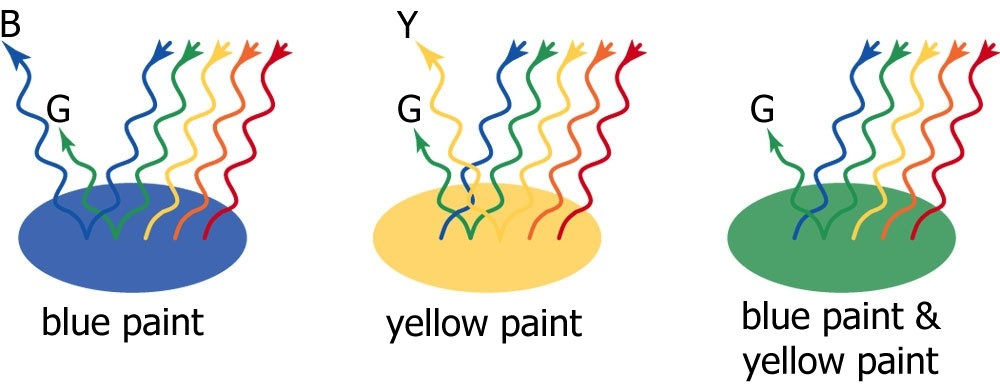
• _____________ colours: colours on opposite sides of the colour circle which, when added, produce greyish-white (Southall, 1937)
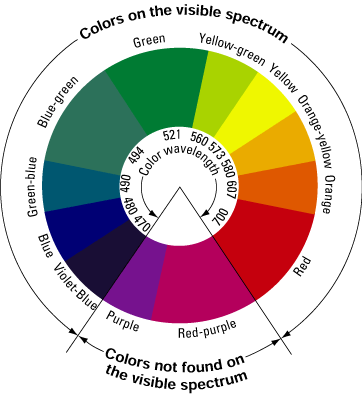
• _________: three wavelengths that, when mixed in certain proportions, can match any other hue
- any primary cannot be matchable by mixing the other two (i.e., use monochromatic lights, not metamers)
- believed to be basic units of colour sensation
- primaries define the colour ________ (Maxwell, 1860):
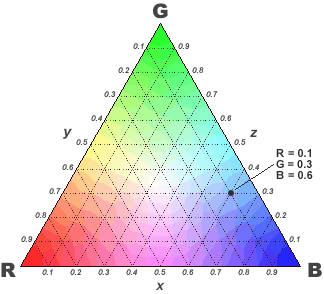
(problem: some test colours not matchable
e.g., spectral yellow requires a ________ primary)
Commission Internationale de l’Éclairage (1932):
- defined bigger, imaginary triangle ("gamut") encompassing all spectral hues to overcome problem of negative primaries
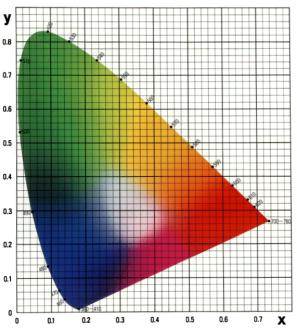
- CIE chromaticity space: hues defined by two numbers: proportion of G and R; thus, p (B) = 1.0 - [p (G) + p (R)]
- add another dimension for brightness
- any hue may be specified in terms of these primaries
Application: buying an HDTV
- HDTVs are based on the Rec. 709 colour standard
- UHDTVs (including 4K TVs) are based on the Rec. 2020 standard, which has a larger gamut
- scotopic vision: only rods function; no colour
- thus cones are responsible for colour vision--but how?
Thomas Young (1802):
- proposed that only three different types of receptors are needed, each sensitive to a different __________
Hermann von Helmholtz (1860, following James Clerk Maxwell, 1857):
- provided evidence that mixing three primary colours would match any given colour
Evidence:
• colour-matching experiments: observers can match a given colour by combining proportions of three primaries together
• physiological evidence: measure wavelength of light absorbed by cones using microspectrophotometer
- three types of pigment found in three types of cones:
▸ ___________ (“red-catching”): long λ (558 nm)
▸ chlorolabe (“green-catching”): medium λ (531 nm)
▸ _________ (“blue-catching”): short λ (419 nm)
- different wavelengths produce different activations in each receptor type
Ewald Hering (1878):
- phenomenological observations led to questions:
How many primary colours do there seem to be?
Can all colours be combined the same way?
- proposed that basic colours come in opposing _____:
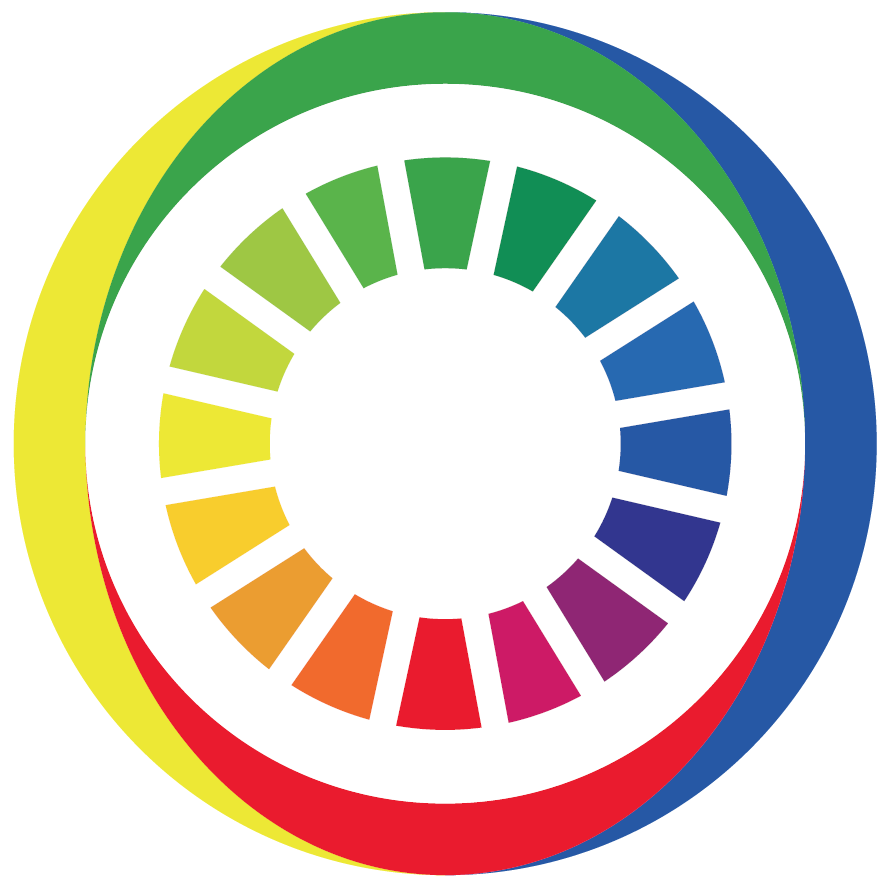
Evidence:
• __________: visual sensation appearing after adapting to a stimulus; produces opposite colour
• simultaneous colour ________: surrounding an area with a colour changes the appearance of the surrounded area
• ___________: infants get bored of looking at the same thing
Bornstein, Kessen, & Weiskopf (1976):
- presented 510 nm (![]() ) light to 4-month-olds until bored
) light to 4-month-olds until bored
- changed to 540 nm (![]() ) light: still bored
) light: still bored
- changed to 480 nm (![]() ) light: excited!
) light: excited!
- adults categorize 540 nm as green, 480 nm as ____
- infants categorize colours like ______ do (four basic colour categories)
• physiological evidence: centre-surround cells have opposing receptive field regions of bright and dark--what about colour?
Svaetichin & MacNichol (1958):
- measured output of __________ cells of fish in response to coloured stimuli
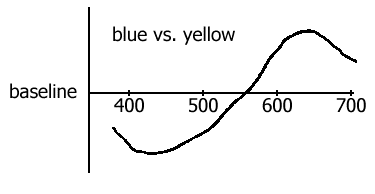
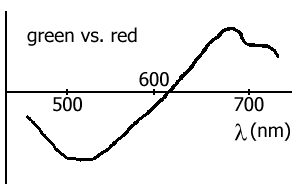
- cells have either/or responses to colour pairs
How are colour-opponent cells neurally wired?
Hurvich & Jameson (1957, 1974): Two-stage theory:
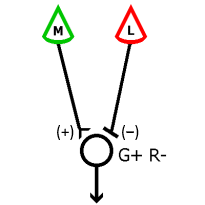
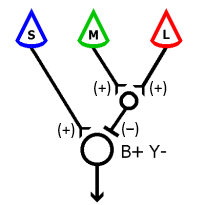
- opponent process obtains a __________ function for the associated pair of wavelengths
- colour-________ cells found in blobs (V1 layers 2 & 3):
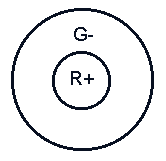
- V1 layer 4 and V4 have double colour-________ cells:
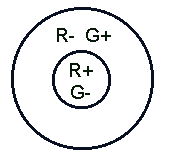
• identified using Ishihara test (1972):
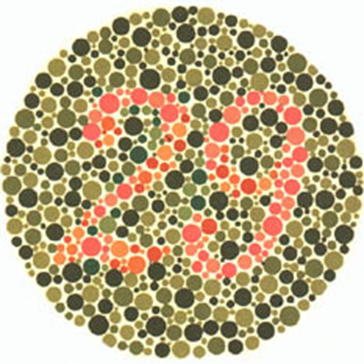
- ___ monochromacy: no cones (incidence: 1 per 100,000)
- cone monochromacy: one type of cone only
▸ blue-cone monochromats: more common
- dichromacy: two types of cone only
▸ __________ (long λ cone-deficient): perceives spectrum as blue-yellow; red-green colour blindness
▸ ____________ (medium λ cone-deficient): perceives spectrum as blue-yellow; red-green colour blindness
▸ __________ (short λ cone-deficient; very rare): perceives spectrum as blue-red; blue-yellow colour blindness
- anomalous ___________: have all types of cones, but one type is abnormal; are poor at discriminating hues
- in general, males affected more than females, indicating a sex-linked condition: genes for producing photopigments are on the X chromosome
Perception of an object’s colour remains constant, despite variations in the quality of ____________.
Disrupted by:
• _________ adaptation: prolonged exposure to a particular wavelength causes cones to be less sensitive to it
• ______ colour: characteristic colour of a familiar object may influence colour perception
e.g., cutouts labelled “lemon” (or banana-shaped) will be matched to a ________ hue than a triangle cutout
Duncker (1939):
- leaf and donkey shapes cut out of green felt
- placed under red illumination: reflected grey
- leaf matched to _______ colour sample than donkey
• misinterpretation of illumination in a photo
Conway & colleagues (2015): What colour is _________?
- blue/black: 57%
- white/gold: 30%
- blue/brown: 11%
- ~10% of people report seeing it switch colours
Possible interpretations:
- white/gold dress seen under “cool” ______ illumination (or due to camera’s white balance, shifting whites to blue)
- blue/black dress in “warm” _________ illumination, overexposed in photo
Wallisch (2017): effects of chronotype
- “_____” are people who tend to get up early and go to bed early
- whereas “____” get up late and stay up later
- larks are exposed to more (bluish) sunlight than owls, who are exposed to more (yellowish) incandescent light
- chronotype accounts for experience of the dress: larks are more likely to see it as white/gold; owls are more likely to see it as blue/black
Perception of an object’s lightness (inherent white/grey/black-ness) remains constant, despite changes in illumination.
illuminations |
× |
reflectance |
= |
retinal _________ |
(light falling on a surface) |
(proportion of light reflected from a surface) |
(amount of light on retina) |
Burzlaff (1931):
- presented two sets of 48 squares, ranging from white-grey-black: one in a dim corner, the other by a window
- selected one square from window set as the standard
- observers chose comparison square from dim set equal in greyness to standard
e.g., standard had 78% reflectance, comparison had 72%
- but standard was under 20× more illumination
illumination |
reflectance |
amount of light |
|
standard |
200 |
78% |
= 156 |
comparison |
10 |
72% |
= 7 |
- observers still made (almost) the correct decision
- _____ principle: percentage of light reflected from an object (compared to illumination) determines perception of lightness
Gelb (1929): Gelb effect
1) black disk placed in (seemingly) dim illumination (but hidden light source provided extra illumination)
- observers reported seeing a _____ disk in dim light
2) white paper placed in front of the black disk
- observers reported that disk was now _____
- knowledge of true ambient light is crucial to ratio principle
We tend to see the “true” lightness of an object--as long as we know what the ____________ is
__________ effect (1965):
1. look at vertical black & green stripes for 5 sec. each, alternately looking at horizontal red & black stripes, for a total of 5 minutes
2. then look at a pattern of horizontal and vertical black & white stripes
• vertical whites appear reddish; horizontal whites look greenish
- but no afterimages on blank white paper
• due to fatigue of cortical (not retinal) coloured-line detecting cells?
• aftereffects may last for _____
• duration can be changed by consumption of coffee and some psychoactive drugs
• stronger in extroverts than introverts, and might be a reliable test for ____________
Colour and Information Design
• ________ identification: it is difficult to identify (or categorize) unidimensional stimuli (whereas it is easy to identify complex stimuli like faces)
e.g., poor performance on colour recognition task
• ________ identification: the task is easier if a comparison scale is provided
e.g., good performance identifying temperature on colour-coded map
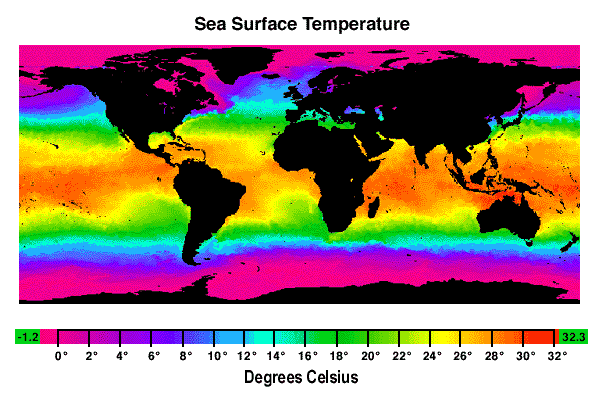
- _________ coding of colour with other means (e.g., patterns) accommodates those with color deficiencies, and allows interpretation from black & white printout
e.g., good air traffic control or graph symbols: redundant coding by colour and shape:
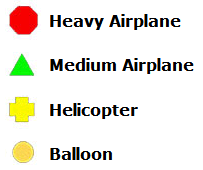
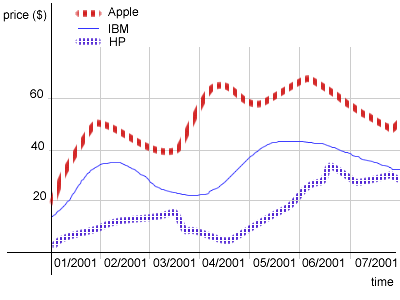
Ackerman (1990): emotion and colour
- Baker-Miller (bubblegum) pink: inmates placed in bright pink prison cells exhibited less aggressive behaviour (failed to be replicated; behaviour change attributed to the _______ of the colour)
- blue light: calms _______ in patients
- “green rooms”: restful effects
- ___: increases appetite; handgrip strength increased 15%
Kwallek et al. (1997): colour and work
- evaluated performance of clerical workers on the Minnesota Clerical Test
- workers randomly assigned for a week to rooms with red, blue-green, or white colour schemes
- results:
• overall, performance poorest in white room and best in red room--even though white was preferred and red was considered “___________”
• poor screeners (those who have trouble blocking out noise/distractions) were less productive and more error prone in red room
• good screeners (having a greater ability to concentrate) performed better in red room
- red may increase _______, which can enhance performance up to a certain level; beyond that, increased arousal interferes with performance
Frank & Gilovich (1988): the colour black
- students unfamiliar with sports asked about their perceptions of pro team jerseys
• teams wearing uniforms at least 50% black: considered to be more “__________” on a scale of opposite terms (like good/bad, nice/mean, and timid/aggressive)
e.g., LA (now Las Vegas) Raiders, Pittsburgh Steelers, New Orleans Saints; Vancouver Canucks, Boston Bruins
   |
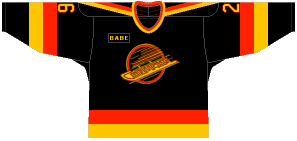 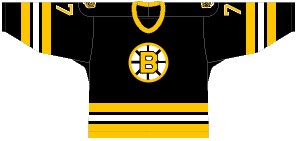 |
[gridiron-uniforms.com] |
[nhluniforms.com] |
- studied game-related penalties incurred by NHL and NFL teams:
• presence of a black uniform related to _________
• two NHL teams (Vancouver and Pittsburgh) changed their uniforms to black in the late 1970s: became more aggressive (increased penalty minutes)
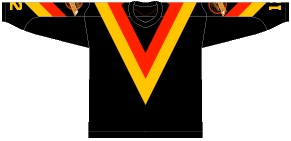
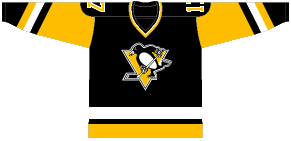
[nhluniforms.com]
- experienced football referees watched two staged games:
• rated teams wearing black uniforms more __________ than those wearing light uniforms (even when the teams performed nearly identical actions)
- college students, grouped into imaginary teams, were asked to select a number of sports their teams might play:
• opted for more aggressive sports when wearing black overshirts
- confirmed in a later study (Vrij, 1999):
• offenders and suspects who wore black clothes were seen as more aggressive than those who wore light-coloured clothes
Buckalew & Coffield (1982): effects of drugs suggested by capsule colours
- black, grey, tan, brown: not preferred
- white: analgesics/_________
- orange or yellow: stimulants/antidepressants
- lavender: ______________
- larger capsules: stronger; injections > pills
Kirsch (2006): reviewed colour and placebo effects
- blue placebo pills: depressant effects
- red placebo: stimulant effects
- yellow placebo: antidepressant effects
- green placebo: reduces anxiety
- better _____ with blue placebo pill than orange
- red placebos more effective pain reliever than white, blue, or green
Miller & Kahn (2005):
- Crayola® started with six colours (black, blue, brown, green, orange, and red) but now has 120, some of which are ___________ named
- other examples:
• Ben & Jerry’s® Chubby Hubby®
• Gatorade Frost® Glacier Freeze®
• Hard Candy’s Trailer Trash
- studied effects of ambiguous names
- after carrying out task on a computer, participants selected jelly beans labeled one of two ways:
• common ___________: blueberry blue, cherry red, chocolate brown, marshmallow white, tangerine orange, watermelon green
• _________: moody blue, Florida red, Mississippi brown, white Ireland, passion orange, monster green
- _________ load was manipulated during selection:
• high cognitive load: additional questions asked while selecting
• low: no questions asked
- number of jelly beans taken was recorded
- results:
low load |
high load |
|
common descriptive |
7.8 |
6.3 |
ambiguous |
18.0 |
6.1 |
- under low cognitive load, participants chose jelly beans with _______ names more often
- resolving ambiguity is cognitively _________ (and reinforcing)